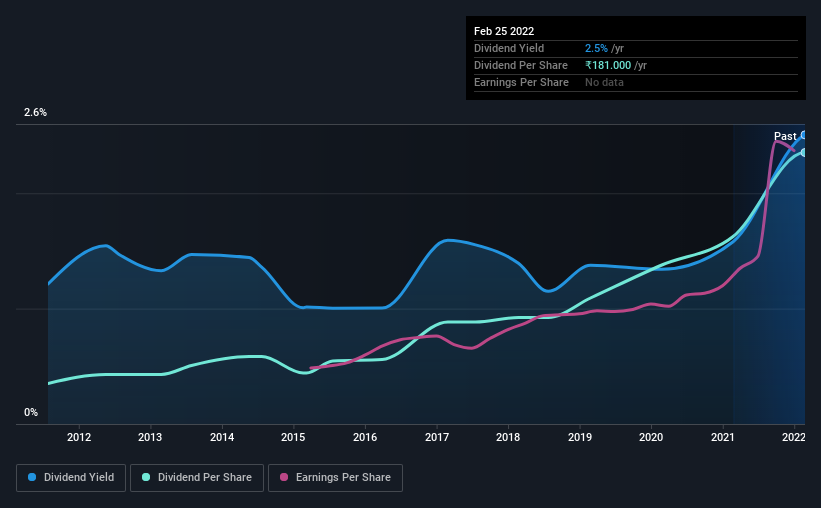
Sanofi India Limited (NSE:SANOFI) has announced that it will be increasing its dividend on the 4th of May to ₹490. This will take the annual payment from 2.5% to 6.8% of the stock price, which is above what most companies in the industry pay.
See our latest analysis for Sanofi India
Sanofi India Is Paying Out More Than It Is Earning
A big dividend yield for a few years doesn't mean much if it can't be sustained. Prior to this announcement, Sanofi India was quite comfortably covering its dividend with earnings and it was paying more than 75% of its free cash flow to shareholders. By paying out so much of its cash flows, this could indicate that the company has limited opportunities for investment and growth.
EPS is set to grow by 25.4% over the next year if recent trends continue. However, if the dividend continues growing along recent trends, it could start putting pressure on the balance sheet with the payout ratio reaching 117% over the next year.

Dividend Volatility
The company's dividend history has been marked by instability, with at least 1 cut in the last 10 years. Since 2012, the first annual payment was ₹27.00, compared to the most recent full-year payment of ₹181. This works out to be a compound annual growth rate (CAGR) of approximately 21% a year over that time. Sanofi India has grown distributions at a rapid rate despite cutting the dividend at least once in the past. Companies that cut once often cut again, so we would be cautious about buying this stock solely for the dividend income.
The Dividend Looks Likely To Grow
With a relatively unstable dividend, it's even more important to evaluate if earnings per share is growing, which could point to a growing dividend in the future. It's encouraging to see Sanofi India has been growing its earnings per share at 25% a year over the past five years. The company's earnings per share has grown rapidly in recent years, and it has a good balance between reinvesting and paying dividends to shareholders, so we think that Sanofi India could prove to be a strong dividend payer.
In Summary
Overall, this is probably not a great income stock, even though the dividend is being raised at the moment. The low payout ratio is a redeeming feature, but generally we are not too happy with the payments Sanofi India has been making. We would probably look elsewhere for an income investment.
Market movements attest to how highly valued a consistent dividend policy is compared to one which is more unpredictable. At the same time, there are other factors our readers should be conscious of before pouring capital into a stock. For example, we've identified 2 warning signs for Sanofi India (1 is significant!) that you should be aware of before investing. Is Sanofi India not quite the opportunity you were looking for? Why not check out our selection of top dividend stocks.
New: Manage All Your Stock Portfolios in One Place
We've created the ultimate portfolio companion for stock investors, and it's free.
• Connect an unlimited number of Portfolios and see your total in one currency
• Be alerted to new Warning Signs or Risks via email or mobile
• Track the Fair Value of your stocks
Have feedback on this article? Concerned about the content? Get in touch with us directly. Alternatively, email editorial-team (at) simplywallst.com.
This article by Simply Wall St is general in nature. We provide commentary based on historical data and analyst forecasts only using an unbiased methodology and our articles are not intended to be financial advice. It does not constitute a recommendation to buy or sell any stock, and does not take account of your objectives, or your financial situation. We aim to bring you long-term focused analysis driven by fundamental data. Note that our analysis may not factor in the latest price-sensitive company announcements or qualitative material. Simply Wall St has no position in any stocks mentioned.
About NSEI:SANOFI
Sanofi India
Manufactures and trades in drugs and pharmaceutical products in India, Singapore and internationally.
Excellent balance sheet average dividend payer.
Similar Companies
Market Insights
Community Narratives




